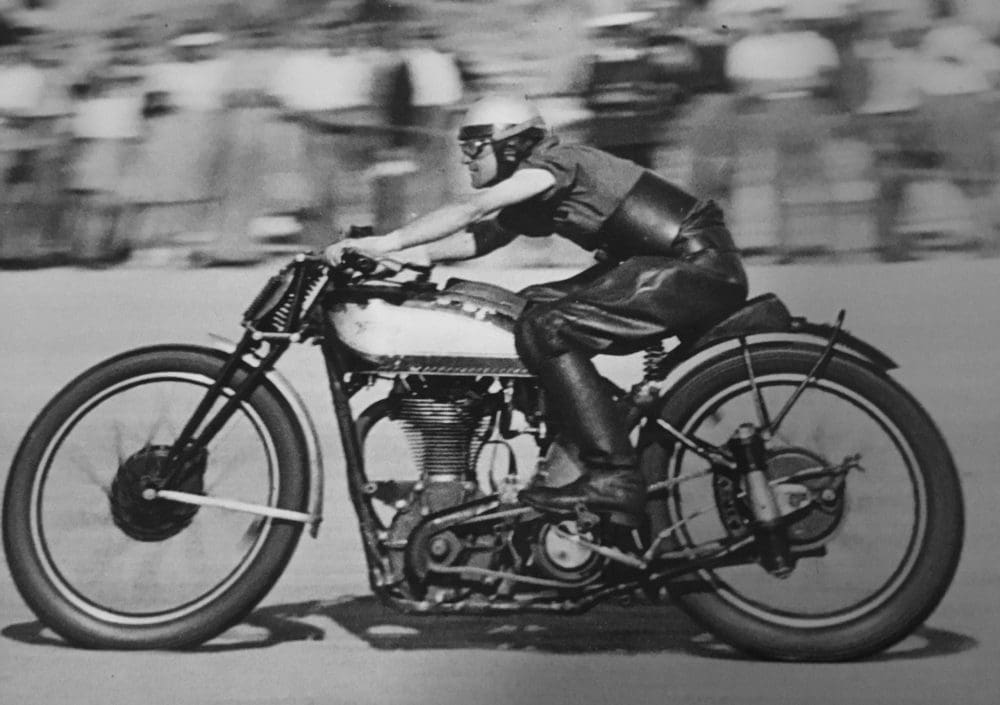Born in 1916, this South Aussie built a life around racing and building bikes
As a 20-year old in 1936, Bruce Hector trapped rabbits to buy a Norton International so he could road race. In his late 80s, he was patron of the Veteran and Vintage Motorcycle Club of South Australia and cut a dapper figure when he and wife of 60 years Enid made club runs on his Norton Big Four or 16H outfits.
Bruce Hector competed in two iconic events in his home state, the 1936 South Australian TT at Victor Harbor and 1938 Australian TT on the awesome Lobethal circuit. In 1939 he was a state representative in the Australian 500 TT at Phillip Island, finishing third.
Hector’s longevity made him a great source of eye-witness experience on those events. Talking with GP crew chief Jeremy Burgess at a Lobethal anniversary function, he observed: “if you went off in the very fast curves after Lobethal township Jeremy, you were dead!”
“I was born and raised in Balhannah in the Adelaide Hills,” Bruce told the author in 2002.
“I’d started on bikes at 15, with a chain-belt Levis and then a new 1933 Norton I had for two years. I did two race meetings at Sellick’s Beach, winning two races the first time and taking a win and a second the next time. I didn’t race again until 1936, when I bought the Norton with 11 and a quarter to one compression to run on alcohol.”
In the teeth of the Great Depression, he saved the₤100 pound for the bike by selling rabbit skins and carcases. He later worked as the groundsman for the boss of Johnson’s brewery.
“Victor Harbor was the first road race I had ever seen, and I was in the middle of it, so I learned fast.” The opposition included Irish superstar Stanley Woods.
“My Norton racer was brand new. I thought I had the quickest bike in the race, but I didn’t know how to ride it. Thought I did, but I didn’t!
“As well as that, the superfast filler cap was a dud. It leaked horribly and alcohol got onto my goggles.” He finished eighth after losing time with a damaged footrest and two pit stops.
In 1937, Bruce rode in the first Lobethal meeting, the South Australian TT. The circuit was only 10km north from his home, so he learned the course on his Norton ES2 touring machine. He recalls finishing second in his first all-tarmac race, only to be disqualified for having a pusher at the start.
“It was about the only circuit in Australia that was tar all the way around.”
But the big news in 1937 for motorcyclists was the appearance of two supercharged two-stroke DKW 250s from Germany.
“In 1938, I was invited to send the engine to the Norton factory. It returned with 13.5:1 compression. Unfortunately, it vibrated so much that the fuel cap fell to pieces and into the tank. I was running third behind Denis Minett and George Hannaford on the last lap when I ran out of fuel.”
One month later Hector was third at Phillip Island in the 1939 Australian TT and ended the year with third place in the 1939 South Australian TT.
“Disaster struck near the finish at Phillip Island when the engine seized, but I freewheeled over the line and got pipped for second (by Doug James). It was the roughest road race in the world at the time! Just gravel and washouts. But I handled it. I had grown up riding on gravel roads in Adelaide Hills and didn’t know any better!
“During the War I moved to Melbourne to work at the Commonwealth Aircraft Corporation factory and later I joined the Air Force.”
Post-War, Hector had a motor garage in Balhannah, bought two shops with the objective of starting a motorcycle business in Adelaide, went farming for 22 years at Strathalbyn and then returned to his first love, building motorcycles.
But he wasn’t done with racing quite yet. Bruce took a win at Woodside early in 1946, third place in the unofficial Australian TT at Woodside later that year and a fourth place at Ballarat on his Norton.
“The 125 class was just opening up, so I bought a BSA Bantam, nutted out a close-ratio gearbox in just three weeks, went to the Harley Club of Victoria anniversary meeting at Fisherman’s Bend in 1950 and won.
“I won at Woodside and again at the (1951) Centenary meeting for the discovery of gold at Ballarat. The last time I rode the 125 was at Darley, where I finished third. Bert Flood was coming good with his scooter, Eric Walsh too.
“I was loaned a brand new AJS 7R for Bathurst, but I didn’t do any good and gave racing away in 1952.”
